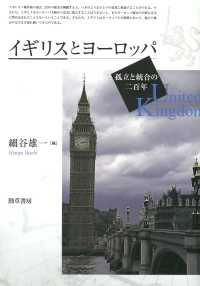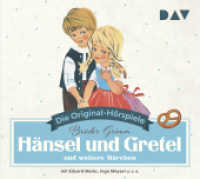- ホーム
- > 洋書
- > 英文書
- > History / World
Full Description
Late medieval and early modern cities are often depicted as cradles of artistic creativity and hotbeds of new material culture. Cities in renaissance Italy and in seventeenth and eighteenth-century northwestern Europe are the most obvious cases in point. But, how did this come about? Why did cities rather than rural environments produce new artistic genres, new products and new techniques? How did pre-industrial cities evolve into centres of innovation and creativity? As the most urbanized regions of continental Europe in this period, Italy and the Low Countries provide a rich source of case studies, as the contributors to this volume demonstrate. They set out to examine the relationship between institutional arrangements and regulatory mechanisms such as citizenship and guild rules and innovation and creativity in late medieval and early modern cities. They analyze whether, in what context and why regulation or deregulation influenced innovation and creativity, and what the impact was of long-term changes in the political and economic sphere.
Contents
Preface; Innovation and creativity in late medieval and early modern European cities: an introduction, Karel Davids and Bert De Munck; The cities of glass: privileges and innovations in early modern Europe, Corine Maitte; Craft guild legislation and woollen production: the Florentine Arte della Lana in the 15th and 16th centuries, Francesco Ammannati; New products and technological innovation in the silk industry of Vicenza in the 15th and 16th centuries, Edoardo Demo; To kill two birds with one stone: keeping immigrants in by granting free burghership in early modern Antwerp, Jan de Meester; The secret perfume: technology and the organization of soap production in northern Italy between the 16th and 18th centuries, Alberto Grandi; Textiles manufacturing, product innovations and transfers of technology in Padua and Venice between the 16th and 18th centuries, Andrea Caracausi; The spatial side of innovation: the local organization of cultural production in the Dutch republic, 1580-1800, Claartje Rasterhoff; Beyond exclusivism: entrance fees for guilds in the early modern Low Countries, c. 1450-1800, Bert De Munck and Karel Davids with the collaboration of Ellen Burm; The coopers' guilds in Holland, c. 1650-1720: a market logic?, Janneke Tump; The early modern Antwerp coopers' guild: from a contract-enforcing organization to an empty box?, Raoul De Kerf; The paradox of the Antwerp rose: symbol of decline or token of craftsmanship?, Annelies De Bie; Harbouring urban creativity: the Antwerp Art Academy in the tension between artistic and artisanal training in the late 17th and 18th centuries, Dries Lyna; Innovation in the capital city: central policies, markets and migrant skills in Neapolitan ceramic manufacturing in the 18th century, Alida Clemente; Innovations, growth and mobility in the secondary sector of Trieste in the 18th century, Daniele Andreozzi








